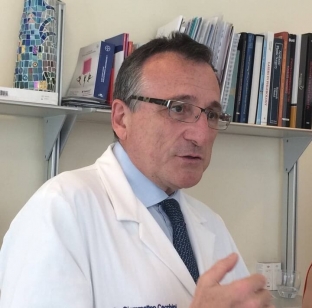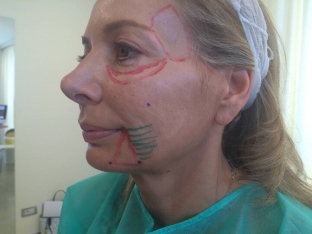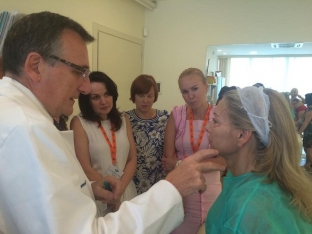To obtain a good aesthetic result when working with patients older than 40 years, it is necessary to take into account the features of the anatomy of the face with age-related changes. Professor Giammateo Cecchini.
shared his secrets of managing such patients with Estet-portal
What do you think is the protocol for managing patients with nasolabial folds older than 40 years?
When a patient comes to us and starts complaining that he has nasolabial folds, I always start working on the following protocol. First, I make a correction of the volume of the zygomatic region. This is very important for lifting the nasolabial fold. After filling in the zygomatic area, I proceed to the correction of marionette wrinkles and only then I look at how the nasolabial folds look. In no case should you start your work with nasolabial folds. Before starting a correction, it is necessary to take into account not only the condition of the skin and muscles. It is important to take a correct history and focus on the resorption of the bones of the skull, which gives changes in facial features due to the displacement of fat pads.
There are many fat pads in our face, which are divided into deep (3 deep fat pads) and superficial (4 superficial) .
Remember that there are partitions between the fat packs that separate them. There is also diffusion of hyaluronic acid between them. If we correctly inject preparations based on hyaluronic acid, and then distribute the preparation with the help of massage movements, then it will be correctly distributed between these structures.
With age, many patients lose facial volume in some areas and, due to displacement, acquire unnecessary volume in others. Age-related changes in fat packages are not the same, and this must be taken into account. Usually, if we consider the infraorbital region, then this package does not lose volume with age. The same picture is observed with the nasolabial fat package. Volume loss with age will occur in the medial and lateral fat pads. It is this change that leads to the fact that clinically we will see the overhang of the nasolabial folds. These symptoms will give the face the appearance of fatigue. Our task is to restore this volume.

What drugs do you prefer to work with in your practice?
In order to work correctly, I suggest doing the correction with cannulas. There are many blood vessels and nerves in this area. A good knowledge of the anatomical structures will save you from mistakes and complications. If you use a needle, you will need to inject deeply, you will not have the "visible vein effect" and you will need to use more drug.
The choice of material you are going to make corrections should always be approached very carefully and creatively. If you want to perform deep injections, then in this case, use Aliaxin EV, and if you need to perform subcutaneous correction, then it is better to use Aliaxin GP.
Another very important area is the cheeks. It is necessary to correctly consider the problem of the nasolacrimal trough, to fix the area between the cheek and the eye.
If you want to replenish the amount of deep fat you have lost, work deep with Aliaxin EV, which can be re-injected.
When we do not see deep changes, then it is better to correct with more superficial and light preparations, such as Aliaxin SR.
We know from anatomy that the lateral part of the face is the safest. In this part, we can work with a needle without any fear. As for the middle part of the face, the situation is completely different - you need to work in it very carefully, because. there is a risk of complications. Therefore, if you decide to carry out a correction in the middle part of the face, then use only the cannula! If you still need to inject with a needle, do not forget to aspirate at the injection point. It must be remembered that in this area there is a high probability of vascular embolism.

What complications are possible with the introduction of hyaluronic acid preparations?
One of the most dangerous complications that any doctor can face in his practice and what patients from other doctors most often come with is getting the drug directly into the vessel. How to understand that a vessel embolism has occurred? This is a very important issue that some doctors do not pay attention to in time. And the reaction time of the doctor in this situation plays a very important role, and it is necessary to take appropriate measures as quickly as possible. Most physicians miss the first symptoms of vascular embolization.
What symptoms should you always pay attention to in case of complications?
Be attentive to your patients. Of course, we focus our attention on how to correct this or that cosmetic defect, because we, as sculptors, must monitor the volume that we create in fabrics. But it is necessary to communicate with the patient during the procedure and monitor his condition in general. So, what happens during a vascular embolism?
Firstly, the patient begins to complain of a sensation of pain. It is important to note that the pain that has appeared is of a different nature than from the introduction of a hyaluronic acid preparation. The patient will feel severe pain and burning at the injection site. If such symptoms appear, then it is necessary to immediately stop the administration of the drug!
Secondly, the color of the skin at the injection site changes immediately. If during the normal administration of the drug the skin becomes hyperemic, then during embolization it becomes white with a grayish tint. Sensitivity may sometimes decrease in this area.
If you see such a reaction while working with a hyaluronic acid needle, immediately start the appropriate therapy - the introduction of hyaluronidase.
In my practice, I try to work only with cannulas. It is safe for both my patients and me.
How to choose the right cannula for safe work?
Firstly, if in your practice you decide to choose a cannula, for example, size 27, then you must remember that this cannula is too thin and becomes more like a needle in its properties. Accordingly, in your work you should expect results from it as from working with a needle. If you work fast and need to push the septa between fat pads with force, you are more likely to puncture or damage large vessels when using cannula number 27. When working with a thicker cannula (number 22), such damage cannot be caused. That is, it is safer to use more channels.
The second reason for choosing a thicker cannula when working in deep layers is the stiffness of the cannula itself. When we go deep into the tissues, we often need to make significant efforts. This can bend and change the course of the thin cannula, and you will no longer be sure where exactly the end of the cannula will be after insertion. This situation is completely impossible when working with a thicker cannula. Its rigidity will provide you with a clearer hit in the required area, which is correspondingly safer.
A third reason for choosing a thicker cannula is less soreness. If you try to prick your hand with a thin canal several times, and then do the same with a thicker one, you will feel the difference on your hand. What is more comfortable? Touching a thick cannula will be less painful, touching a thin cannula will feel like a needle prick.
It is for these reasons that it is better to choose thicker and stiffer cannulas for working with deep layers of the face.
Author: Elena Stoyanova, who attended the training of Professor Giammatteo Cecchini in Pisa, Italy.







Add a comment